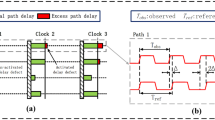Abstract
In today’s semiconductor industry, where time-to-profit is a critical factor to remain competitive, missing the tight market window might have serious implications including the risk of product cancellation. This places severe pressure on every aspect related to the design and the verification of semiconductor chips to get the design ready for manufacturing in the shortest time possible. To avoid the need for costly corrective steps and silicon re-spins during post-silicon verification, thorough pre-silicon verification is essential to catch any design fault and estimate the design overall reliability before the design is manufactured. This paper presents a novel EDA tool that helps the verification team improve the verification process in several ways. It can be used to generate useful statistics regarding the complexity and the coverage of the created test vectors. Experimental results prove that the verification team can successfully use the proposed tool to set their target coverage and intelligently select the set of test vectors that achieves that target using the minimum number of computing cycles.
Similar content being viewed by others
References
Aickelin U (2002) An indirect genetic algorithm for set covering problems. J Oper Res Soc 53:1118–1126
Balas E, Carrera MC (1996) A dynamic subgradient-based branch-and-bound procedure for set covering. Eur J Oper Res 44:875–890, November
Beasley JE, Chu PC (1996) A genetic algorithm for the set covering problem. Eur J Oper Res 94:392–404, October
Beiu V, Rückert U, Roy S, Nyathi J (2004) On nanoelectronic architectural challenges and solutions. Proc IEEE Conf Nanotech, IEEE-NANO’04, Munich, Germany, pp 628–631, Aug.
Bourianoff GI (2003) The future of nanocomputing. IEEE Comput 36:44–53, August
Bryant RE, Cheng KT, Kahng AB, Keutzer K, Maly W, Newton R, Pillegi L, Rabaey JM, Sangiovanni-Vincentelli A (2001) Limitations and challenges for computer-aided design technology for CMOS VLSI. Proc IEEE 89:341–365, March
Cadence Functional Verification Kit for ARM, available at, http://www.cadence.com/datasheets/arm_func _ver_kit.pdf
Cheng W-T (2000) Current status and future trend on CAD tools for VLSI testing. Proc 9th Asian Test Symp, ATS’00, Taipei, Taiwan pp 10–11, December
Corno F, Prinetto P, Rebaudengo M, Sonza Reorda M, Veiluva E (1995) A portable ATPG tool for parallel and distributed systems. IEEE VLSI Test Symp, Princeton, USA, pp 29–34, April
Corno F, Rebaudengo M, Sonza Reorda M, Violante M (1999) Optimal vector selection for low power BIST. Proc IEEE Int Symp on Defect & Fault Tolerance in VLSI Sys., DFT’99, Albuquerque, New Mexico, USA, pp 219–226, November
Davis JA, Venkatesan R, Kaloyeros A, Beylansky M, Souri SJ, Banerjee K, Saraswat KC, Rahman A, Reif R, Meindl JD (2001) Interconnect Limits on Gigascale Integration (GSI) in the 21st Century. Proc. IEEE 89:305–324, March
De Bontridder KMJ, Halldorsson BV, Halldorsson MM, Hurkens CAJ, Lenstra JK, Ravi R, Stougie L (2003) Approximation algorithms for the test cover problem. Math Program 98:477–491
De Bontridder KMJ, Lageweg BJ, Lenstra JK, Orlin JB, Stougie L (2002) Branch-and-bound algorithms for the test cover problem. Proc of the 10th Eur Symp on Alg (ESA’02) vol. 2461, Springer, Heidelberg, pp 223–233
Edbom S, Larsson E (2004) An integrated technique for test vector selection and test scheduling under test time constraint. Proc 13th Asian Test Symp 254–257, November
Forshaw M, Stadler R, Crawley D, Nicoliæ K (2004) A short review of nanoelectronic architectures. Nanotechnology 15:S220–S223, April
Frank DJ, Dennard RH, Nowak E, Solomon PM, Taur Y, Wong H-SP (2001) Device scaling limits of Si MOSFETs and their application dependencies. Proc IEEE 89(3):259–288, March
GAlib, “A C++ Library of Genetic Algorithm Components”, version 2.4.6. Available at http://lancet.mit.edu/ga/
Garey MR, Johnson DS (1979) Computers and intractability: A guide to the theory of NP-completeness, Freeman, San Francisco
Grosman T, Wool A (1997) Computational experience with approximation algorithms for the set covering problem. Eur J Oper Res 101:81–92, August
Harlow JE III (2003) Toward design technology in 2020: Trends, issues, and challenges. Proc Intl Symp VLSI (ISVLSI’03), Tampa, FL, USA, pp 3–4, February
International Technology Roadmap for Semiconductors (ITRS), 2005 Edition and 2006 Update, Intl. SEMATECH, Austin, TX, USA, Available at http://public.itrs.net/
Krishnamurthy N, Abadir MS, Martin AK, Abraham JA (2001) Design and development paradigm for industrial formal verification CAD tools. IEEE Des Test Comput 18:26–35, August
Lajolo M, Rebaudengo M, Reorda MS, Violante M, Lavagno L (2000) Behavioral-level test vector generation for system-on-chip sesigns. Proc IEEE Int. High-Level Design Validation and Test Workshop, Berkeley, CA, USA, pp 21–26, November
Li J, Kwan RSK (2004) A meta-heuristic with orthogonal experiment for the set covering problem. J Math Model Algorithms 3:263–283
Lp_solve, “A Free Linear (integer) Programming Solver, version 5.1.1.3. available at http://lpsolve. sourceforge.net/5.1/
Mead C, Conway L (1980) Introduction to VLSI systems. Addision-Wesley
Meindl JD, Chen Q, Davis JA (2001) Limits on silicon nanoelectronics for terascale integration. Science 293(553):2044–2049, September
Moret B, Shapiro H (1985) On minimizing a set of tests. Siam J Sci Statist Comput 6:983–1003
Ohlsson M, Peterson C, Söberderg B (2001) An efficient mean field approach to the set covering problem. Eur J Oper Res 133:583–599, September
Roychowdhury VP, Janes DB, Bandyopadhyay S (1997) Nanoelectronic architectures for Boolean logic. Proc IEEE 85:574–588, April
Sakurai T (2000) Design challenges for 0.1 μm and beyond. Proc. Asia & South Pacific Design Autom Conf (ASP-DAC’00), Tokyo, Japan, pp 553–558, January
Sen S (1993) Minimal cost set covering using probabilistic methods. Proc ACM Symp on Applied Comp: States of the Art and Practice, pp 157–164
Solar M, Parada V, Urrutia R (2002) A parallel genetic algorithm to solve the set-covering problem. Comput Oper Res 29(9):1221–1235, August
Synopsis Discovery Verification Platform, available at http://www.synopsys.com/products/solutions/ discovery_platform.html
Author information
Authors and Affiliations
Corresponding author
Additional information
Responsible Editor: M. Abadir
Rights and permissions
About this article
Cite this article
Ibrahim, W. A Novel EDA Tool for VLSI Test Vectors Management. J Electron Test 23, 421–434 (2007). https://doi.org/10.1007/s10836-007-5002-x
Received:
Accepted:
Published:
Issue Date:
DOI: https://doi.org/10.1007/s10836-007-5002-x




